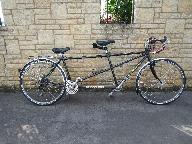Account
Discussions
Cracking rims
Cracking rims
In this context I’m differing from Wallace and his refrain ‘cracking cheese, Gromit’.
A technical question.
I’m an ‘old-school’ cyclist, and spend a lot more time using the machine than I do cleaning it. In fact I hardly clean my ride-to-work machines at all, but I do keep them in reasonable mechanical order. In keeping with the old-school ethos, I’ve yet to get around to disc brakes, as for the riding this machine does, good ol’ fashioned rim brakes suffice.
I’ve just had to re-rim another rear wheel, as it happens on my ride-to-work solo, but over the years I’ve had this problem on the rears of tandems as well. The rim in question is a double eyeletted box section one, a Mavic MA2. It's 36 hole, I’ve built it three cross, stainless plain gauge spokes. I don’t ride with soft tyres (700 x 25), normally they’re inflated to around their maximum pressure. The wheel has had a fair bit of use, but certainly is not through on the braking surfaces, so I don’t consider it worn out
What happens is that a crack starts on the braking surface of the rim, on the outermost edge. Over time, this propagates in towards the inner surface, the face of the rim. When you look casually at the crack, you think it is how the rim is made, where the pinned joint is. On closer inspection you notice more than one join, and the edges aren’t clean but slightly jagged (as you would expect a fracture to have). The cracks seem to be on both sides of the rim, i.e. if there was a crack on one side, it would also be on the other at the same place.
When I noticed that all was not well, there were perhaps four cracks in the rim, in various places on the circumference, some so well advanced so that they could be seen on the face of the rim, others just on the top of where the brake pads rub. They did not happen by the eyelets, but in between the spokes.
Now my question is: how do these cracks appear when the rim is under compression? My understanding of the theory of spoked wheels is that the spokes are in tension, and the ‘pull’ they exert is trying to expand the flange of the hub at the J-bend end, whilst pulling each nipple of the spoke, which are in turn embedded in the rim. The whole loop of metal, the rim, is being pulled in towards the centre of the loop, it is under compression. I can see no plausible mechanism as to how a fracture can start on the outermost surface of this loop. If it was the innermost surface, the face of the rim, it would make sense. In that case, the eyelet is being pulled through the rim by the nipple of the tensioned spoke. I have had this, but only where a catastrophic event has happened (pedal through rotating wheel, fair enough).
In my mind’s eye, a fracture occurs when one part moves relative to another part and the two parts are solidly connected. The only way that these parts can move independently is by the boundary between them breaking. So how can a rim crack on its outermost edge? If I was riding with tyres at low pressure, and whacking up against kerbs, then I would expect the rim to be ‘flatted’. But I don’t, and the rim remained straight throughout, even when I chucked it in the scrap bin.
So any views as to why this rim has cracked in such a way?
Is it the air pressure pushing laterally and fatiguing the rim - maybe helped by the odd bump?
Would have been very interesting to see some close up photos.
I have no data to back this up, but I wonder if such failures could result from temperature cycling with heavy rim braking over an extended period, perhaps worsened by exposure to road salt? The spokes might conduct some heat so perhaps the parts in between would be the hottest? If the coefficient of expansion of the anodized (aluminium oxide) coating is lower than the aluminium then high temperatures might perhaps crack the coating?
Do you tend to do a lot of rear wheel braking? (of course on a tandem that's to be expected but less on a solo?) If not, this guess at a cause is probably wrong! Also, is your commute hilly?
Seems a long shot. A manufacturing fault might be a simpler explanation.
I have heard of other Mavic and other anodized rims cracking but usually from the eyelets. I had an X517 show whitening years back, possibly beginnings of cracking, in front and behind the eyelets, but it did many more miles of off road with no issues.
If you don't clean your rims or brake blocks are you damaging your rims under braking?
Cleaning the rims has never done any arm, Checking the brake pads regurlarly is part of normal maintenace
This sounds very much like fatigue fractures which can occur anywhere there is a cyclic load - very much the case with most bike components. Yes the rim is in compression but that is not necessarily spread evenly across the cross-section - it could well be concentrated on the box section towards the inside diameter of the rim and manufacturing processes (bending the rim around into a circle) could lead to built-in tension. Fatigue will start at some tiny imperfection, a scratch or chip typically, and propagates slowly over time. I would expect low spoke tension to exacerbate the problem, although that often leads to broken spokes. I have had MA2 rims fail due to over-tensioned spokes but in that case the cracks appeared around the rims beside the spoke holes.
I have had may bike parts fail due to fatigue - most painfully, pedal axles! Modern components tend to be much better.
You say you always ride with tyres pumped to near their maximum rated pressure. For a 700x25 and depending upon the tyre, this could be a fairly high pressure 100 psi plus. The fact that the crack starts at the top of the outer circumference of the rim rather than the inner circumference or near the spoke holes says to me that it is more to do with tyre pressure than spoke tensions. Although the tyres are rates of this high pressure rims are not necessarily able to stand it and correct me if I am wrog Chis Juden but I think the maximum outward forc on the rim will be at the rim edge especially when the tyre is under maximum compression such as when hitting a bum or pothole.
Rim brakes if not frequently adjusted, as the brake pads wear, to keep the surface of the brake pad parallel with the rim Can cause a concave wear pattern on the rim making the rim even more susceptible to cracking.
I have experienced all of this with but with fatter tyre than yours which Inwas inflating towards their maximum pressure but Inwould imagine the effect is similar
I think that on a singe bike with the same rims you would probably get away with it but the stresses and strains on rims are obviously greater on a tandem for the same style of riding.
If you look at SJS (Thorn Tandems) websiteI am sure there are some warning thre about not infalting tyres to maximum pressures.
Hope that helps
Steve
Sorry that should be bump not bum.
Apologies for all the typos, I accidentally hit save before proof reading my entry.
Mark,
I am no MEng but build have been building wheels for tandem and solo use 40 years, largely through persistent failures in shop bought stuff the 70s/80s being ex rugby player shaped 6'3" who loads bike kit beyond warranty levels even on solos (Campy is set at 80kg) and then used to cycle camp on RSF type ventures.
Mavic ended MA2 prodution at the end of 1999 according to Jobst B Blog (see https://yarchive.net/bike/rims.html ) and if the rim is red labelled like the one I have left it is pre 96 so simple metal fatigue must be expected on a 25+years old alloy, especially if commuting all weathers in UK. The usual cracking from eyelet holes on hard anodised rims wont affect the MA2 which was polished and"soft"anodised anodised.
Which modern rim are you rebuilding with?
Thank you everyone for your responses. My musings on the matter here follow.
In line with my unfashionable outlook to be unfussed over the cosmetic appearance of most of my bikes, I build them up carefully, making sure all bearings are in best adjustment etc, and then ride the machine into the ground. When it eventually disgraces itself by (not unreasonably) failing, I normally stick it in a far corner of a little used shed and assemble the next lucky machine. The ride-to-work solo with this cracked rim is very close to being ‘rested’ in this way. Eventually I recycle the disgraced machine, and ready it for its next stint.
I’ve been running my ride-to-work machines for the last forty years or so in this manner, and very rarely does either the bike or I fail to make it home. I’ve still got a machine from the 1980’s in some dusty corner that l suppose really has served its sentence, so l should get it out and restore. Sometime.
The original reason for my disdain of ‘pretty’ bikes stems from working in the big city (in my case London). Basically nice looking bikes get stolen. The bad guys have such fancy stealing tools that no lock really acts as a guarantee that your wheels home will be there when you return. So my work-around was to adopt the camouflage of having a good machine with shabby appearance.
This has worked well for me, though is to the consternation of many of my cycle club mates, and I fear would be similarly to most Tandem Club members.
In line with grotty paint, I put on grotty looking bits. As I prefer reliability to ultimate weight saving for the daily commute, and (as mentioned) last year’s model is just fine for me, I’ve evolved to using really quite vintage equipment. It’s usually gloriously out of fashion to use as well, which I would guess by now you’ll be unsurprised to know is just fine with me. So for some decades now I’ve been using Sturmey Archer three speeds. And Williams C34 cottered cranks. And Weinmann 500 side pulls. And Pletscher racks.
But as I do the miles, I’ve gone onto the modern 700C’s, as 26” and 27” wheels and tyres become ever more obscure. (I’m talking about 26 X 1 ¼”, not the smaller mountain bike size). So the way to keep the wheels looking rough is to keep ‘em dirty. Similarly if I can find some used rims that look like they still have life in them, then all the better. Which brings me (eventually) back to my cracked rear.
My guess is that this unfortunate rim had already had a fair life before I built it up into the SA 3-speed. I must have done a fair few thousands of miles since then, so I can’t complain.
Of the observations made about possible failure mechanisms, the commute very rarely was made in extremes of temperature, and has virtually no prolonged braking episodes (the West London journey is near enough flat), so most unlikely to be a heat issue. The tyres, as I said, are usually inflated up to the max specced on the sidewall. No, I don’t commute on the racing Conti’s that I owned that stated this as 160psi! The fair enough comment about possible score lines from grot embedded in the brake blocks I concede is a good theory. For me, if you are attuned to your machine, you can tell immediately if you’re grinding rocks into your wheels by the noise and loss of retardation. Very rarely happens to me. The resulting score line when it does, weakens the sidewall so makes a highly pressured tyre much more likely to exploit the resulting groove and blow through the side of the rim. I’ve seen this happen. And is not recommended. And has never happened to me. And doesn’t really account for the cracking in the rim I suffered.
But the talk of fatigue fractures does seem to me a more likely candidate. The further talk of low spoke tension / being broken is also pertinent, as I confess it was a broken drive side spoke that I was fixing which gave me occasion to look more closely at the wheel. The spoke tension was more relaxed than I reckon is correct, so a good call there as well. But I’m reluctant to join in on the carte blanche line about modern components being much better. I’ll concede my habit of recycling parts of unknown provenance leaves me open to fitting parts that have had a hidden over-stressing by previous owner(s). But so many old parts are consigned to the scrapheap when they are every bit as good as their modern equivalents except for their cosmetic appearance. My decades of cycling on such stuff has not been filled with regular breakages, indeed I feel I suffer such malaises less frequently than many of my newly equipped club mates. The rim dying was/is exceptional and ironically this part was probably the newest part of the whole machine.
I smile at the thought of regularly adjusting ones brake blocks. I applaud those fellows who lavish such attention on your brakes. For me, especially on the ride to work machines, you adjust it correctly the once at set up and that’s it. When they have worn down to the shoe several thousand miles and some years later, you replace. As long as no touch the sidewall of the tyre, and as long as the winter salt doesn’t freeze them up, then if they slow you down, that’s all the attention they get. I look in a bewildered way at my off-roading friends who get through a set of expensive disc pads in a single weekend of riding.
So yes I buy the metal fatigue theory as to what demised my rim, exacerbated by low spoke tension. The way the actual cracks manifest I still can’t really account for. But they do.
If I continue to use old kit that could well have gone through the wars before my time, then I’m probably not dealing myself the best possible hand. But, all things considered, that’s what I do, which is why I’m in the process of rebuilding my long suffering Sturmey Archer hub into a used Weinmann made in Belgium rim (so Alesa) that I’ve dusted down. My guess is that it’s at least 25 years old. It’s not even one of those hard-to-keep-clean-even-if-l-wanted-to concave ones they did. Strangely it’s welded (not pinned), parallel walled and not hook bead. But it looks round and is to hand, so on it goes. And so the cycle continues.






